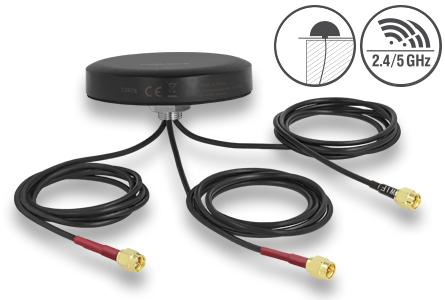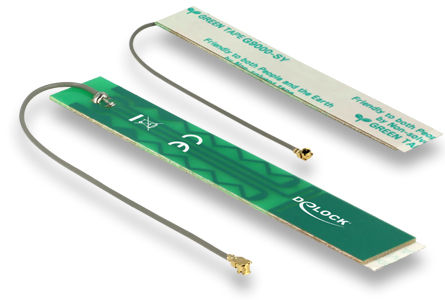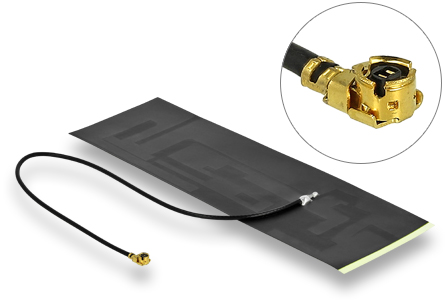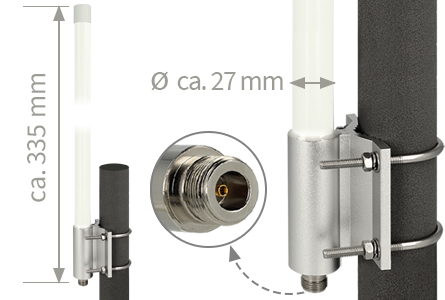Mobile phone standards - from the beginnings till now

What is this article about?
When it comes to mobile technology or standards, sometimes there is confusion. What do these designations with "G" mean? Or, for example, what is the difference between 3G and UMTS? The answer to the last question is quite simple: they are the same thing. But first things first.
The "G" stands for generation
Mobile technology has developed and continues to develop in generations. This is what the "G" stands for. Within a generation there can be several intermediate stages. In the following, the development of mobile radio standards from the beginnings until today is examined; there are practical examples, an outlook on the future as well as currently available Delock articles as examples.
Content
Generations of mobile technology - Overview
Before looking at generations 1 to 5 in detail, here is an overview. It should be mentioned that the years should be taken as a guideline, because there are different views on the exact dates and the development in the respective countries also differs.
- 1G from 1978: analogue cable network; only telephony possible
- 2G from 1993: GSM, GPRS, EDGE technologies; sending SMS possible
- 3G from 2003: UMTS, HSPA, HSPA+ technologies; data transmission / reception + WWW possible
- 4G from 2012: technologies LTE, LTE Advanced, LTE Advanced Pro; all currently known data operations possible (as of mid-2022))
- 5G from 2019: building on LTE; data transmission in real time targeted
- 6G ... dreams of the future: introduction planned for 2030
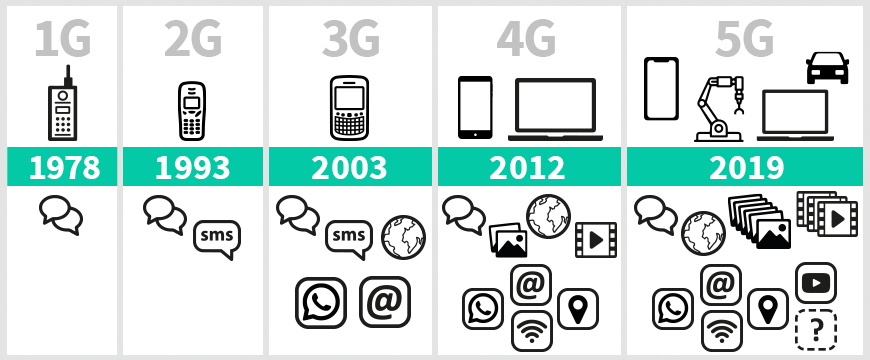
Analogue beginnings, digital present: mobile radio generations in detail
The birth of mobile radio, i.e. wireless communication between two places, can be located in 1879. At that time, David Edward Hughes demonstrated the phenomenon of electromagnetic waves at the Academy of Natural Sciences.
The first analogue mobile radio systems in Germany
The first mobile radio networks in Germany were analogue systems based on the US-American standard AMPS (Advanced Mobile Phone System), which belongs to the first generation = 1G. For the first time in 1952, it was possible to call a subscriber in the fixed network from a mobile terminal in Germany. Emerging radio systems were local in nature, i.e. they served only one city. There was no separate area code for mobile phones.
The caller had to know the whereabouts of the person called, because he could only reach the desired interlocutor via mobile using the area code of the city in which he was located. The connection could only be made via operator. The mobile devices could only be used in the appropriate network. The called party was not allowed to move much, because the connection was interrupted if he left the corresponding radio cell.
The first generation: 1G and its A-Net, B-Net and C-Net
The A-Net
The A-Net came into being in Germany in 1958 with hand-switched connections. The huge mobile devices were installed in cars. During the telephone call, the engine had to be running so that the car battery did not run down. Such a device cost around 15,000 DM. Each base station could be used for any radio telephone.
The B-Net
The B-Net for Germany, Austria, the Netherlands and Luxembourg was introduced in 1972. Roaming between participating countries as well as automatic switching of incoming and outgoing calls was now possible. However, the caller had to know where the destination caller was. For each call, one had to search for a free frequency with a device that resembled a radio, then call the "Fräulein vom Amt" so that she could connect with the subscriber. Establishing a connection was very time-consuming.
The C-Net
In Germany, the C-Net was introduced on May 1, 1986. Now it was possible to automatically transfer a mobile device between the radio cells of a base station, making manual switching obsolete. The location of the mobile device was constantly updated by the automatic mobility management, so that the incoming call did not have to be switched manually.
In contrast to the B-network, the C-network was limited to Germany. In Europe, many of these mobile radio systems emerged in the 1980s, which were not compatible with each other.
The second generation: 2G
Pioneering: the GSM standard
The new GSM standard (Global System for Mobile Communication) was introduced at the beginning of the 1990s (1992 in Germany ); now it was also possible to send SMS. The data transfer rate was a maximum of 9.6 Kbit/s, which was sufficient for sending texts. Mobile telephony was expensive, the devices large. The Siemens P2 phone, weighing about 2 kg, cost over 3000 DM. About one year after the launch, there were about 200,000 people with a GSM mobile phone (for comparison: the A-network had about 11,000 subscribers). The GSM standard was groundbreaking and has remained the technology on which every subsequent generation is built.
Further developments
GSM was first developed into GPRS (General Packet Radio Service). The data rate increased to a maximum of 54 Kbit/s, which was an advance on GSM. But sending a photo or a song, for example, was only theoretically possible. A photo of 2 MB, for example, took about 5 minutes, and transmissions were usually interrupted. GPRS was further developed into EDGE (Enhanced Data Rates for GSM Evolution). With EDGE, the data rate was four times higher (max. 220 Kbit/s), i.e. the transmission was four times faster. EDGE was sufficient for small amounts of data such as e-mail or SMS. GPRS is also called 2.5G, and EDGE 2.75G.
Even today, the 2G network is used in some areas. If you get to a part in Germany where the status bar of your smartphone shows E for Edge, for example, you know that you should now limit yourself to WhatsApp; loading a more complex website takes an extremely long time.
Generations / generation levels and maximum data rates
| GENERATION | TECHNOLOGY | MAX. BANDWIDTH |
| 2G | GSM | 9.6 KBit/s |
| 2.5G | GPRS | 54 KBit/s |
| 2.75G | EDGE | 220 KBit/s |
| 3G | UMTS | 384 KBit/s |
| 3.5G | HSPA | 7.2 MBit/s |
| - | HSPA+ | 42 MBit/s |
| 3.9G | LTE (up to CAT 4) | 150 MBit/s |
| 4G | LTE Advanced | 300 MBit/s |
| 4.5G | LTE Advanced Pro | 600 MBit/s |
| 5G | based on LTE, Network Slicing | 10 GBit/s |
The third generation: 3G
A new era thanks to the UMTS standard
The mobile Internet, as it is currently understood, had its breakthrough with the introduction of the UMTS standard in 2000 / 2001. UMTS stands for Universal Mobile Telecommunications System. Now smaller and larger amounts of data could be sent and received at the same time. The new technology promised huge potentia in the eyes of mobile phone providers.
So it happened that the Federal Network Agency, which auctions off the various frequencies to the mobile phone providers, was given a historically unique investment sum of 50 billion euros. The money went into the federal budget. Later it turned out that it would have been better spent on network expansion, as the network operators no longer had the money for large investments. Even today, network coverage in Germany is far from ideal, a late consequence of the gigantic licence costs.
Further developments
With the HSPA upgrade, also known as 3.5G, the data rate increased to 7.2 MB/s. This was followed by HSPA+, which already managed 42 MB per second. For comparison: when UMTS was introduced, the data rate was only 384 Kbit/s.
The fourth generation: 4G
The giant leap with LTE
The fourth generation of the mobile network, from 2012, is also known as LTE - Long Term Evolution. The data transfer rate has now increased to up to 300 MB/s, with reduced latency times. This means much faster data exchange. With LTE, data transfer is now comparable to domestic broadband internet access. Another advantage of 4G is better reception and reduced susceptibility to interference, as the frequency bands can be used more flexibly.
The Voice over LTE (VoLTE) transmission protocol further improves voice quality. In the meantime, the PC or laptop is no longer the most common access device to the internet, but the mobile phone or smartphone. With the LTE Advanced Pro standard (LTE-AP from CAT 11), the data rate increases to max. 600 MB/s. This technology is also called 4.5G.
The fifth generation: The latest 5G
Breathtaking progression of data rates
In June 2019, the Federal Network Agency concluded the auction for the 5G frequencies. They went to Telekom, Vodafone, O2 and 1&1 Drillisch. As providers of this mobile network, they design its required (physical) infrastructure. Area-wide availability is not yet a given, but it is in the works.
Of course, 5G will differ from its predecessor in terms of data transmission speed: Rates of at least 10 times those of LTE are mentioned. One GB to ten GB per second are to be made possible. Such speeds are not available in the fixed network area, which shows the enormous technological progress with 5G. One can almost speak of data transmission in real time, so low are the reaction and latency times.
5G enables the Internet of Things
5G will play a major role in machine-to-machine (M2M) communication and in the Internet of Things in general. Billions of devices are becoming increasingly networked. Not only computers, tablets and smartphones, but also more and more devices and machines from the domestic sphere (keyword smart home), industrial machines, so-called wearables (devices for monitoring health data) and vehicles are being networked with each other. (For more information, follow the link to look at Delock Info point > IoT).
For private use, the 4G network, i.e. the LTE standard or its infrastructure, will continue to be optimised. For private purposes, the technology is more than sufficient. 5G is of particular importance for industry in the future.
The generations - conclusion
Life cycles of the mobile phone generations

In addition to the original purpose, mobile telephony, data transfer has long been established as the purpose of mobile radio technology. With each mobile radio generation, and also within each generation, data transfer is improved. This means that ever higher data rates are generated with improved latencies. At the same time, network coverage and network capacity are increasing, e.g. so-called dead spots are becoming smaller.
4G / LTE technology will remain the standard for users for the next few years. The further development of mobile communications technology is moving in the direction of data transmission in real time. This opens up enormous areas of application in a networked industry, in manufacturing, in the medical and humanitarian sectors as well as in the administrative and service sectors. (Compare Info point > IoT).
User question: Which standard does my smartphone use?
Delock answers:
That depends on three points: 1. what the smartphone is designed for, 2. the respective mobile phone contract, and 3. which standard is available in the respective area of use. The smartphone then selects the best standard and displays it at the top next to the bar for the network quality. In this way, the smartphone user sees different information depending on the choice of smartphone - but only if mobile data is switched on.
Before 2021, for example, the designations G, GPRS, O or E were visible in the status bar: Different levels of 2G. For 3G, there were the indications 3G, H, 3.5G, 3G+ or H+. In 2021, the UMTS network (= 2G and 3G) was shut down by the owners Telekom, Telefónica and Vodafone in order to be able to use the frequencies for the 4G and 5G standards. Thus, variants of 4G are currently (as of mid-2022) displayed in the status bar of the smartphone, i.e. 4G, LTE, 4G+, LTE-A and LTE+.
Why is network speed so important?
A practical user example: a feature film in HD quality
Basically, the question of speed was already addressed in the explanation of the generations: The higher the data throughput, the more (potential) benefit. This becomes really comprehensible with the example of a video or film that is to be download on a smartphone. Videos require a particularly large amount of data volume. How much in detail depends, of course, on the quality of the film.
Watching a video with 3G is not fun or even possible at all. With 4G (LTE), on the other hand, things look quite different. Here, films can be watched in HD without interruption. To illustrate the extreme progress from generation to generation, the respective loading times for the example "video film" are shown in the following graphic.

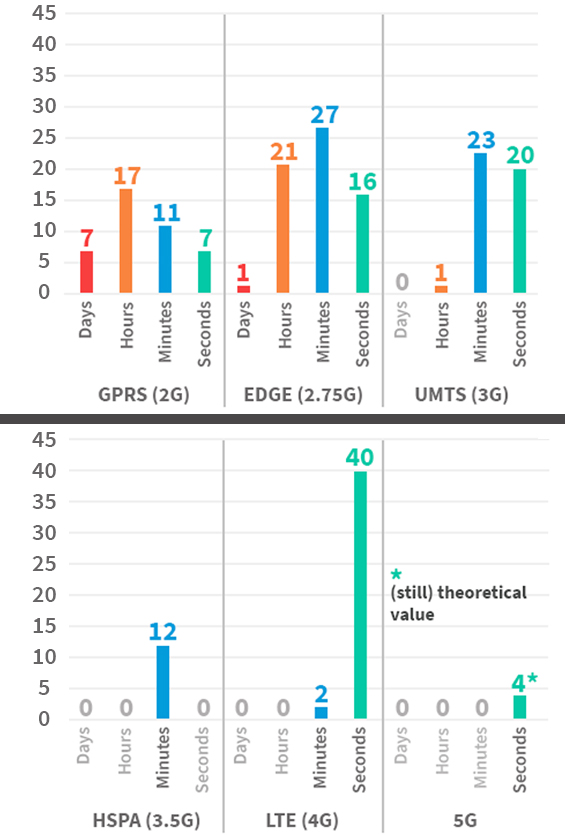
Explanation of the graphic
The example assumes a feature film in HD, with a size of 4.5 GB. In order to watch this film on the 2G net, it would have taken seven days and 17 hours to load it. In addition, this would be a theoretical value, as there would certainly have been several transmission interruptions beforehand.
On the 3G net, or more precisely with UMTS, it takes only one hour and 23 minutes to download the film. Even within 3G, with the HSPA standard, the loading time is reduced to 12 minutes. With LTE from 4G, the film is available after two minutes and 40 seconds. In the 5G network, the film is downloaded after an unimaginably fast four seconds.

